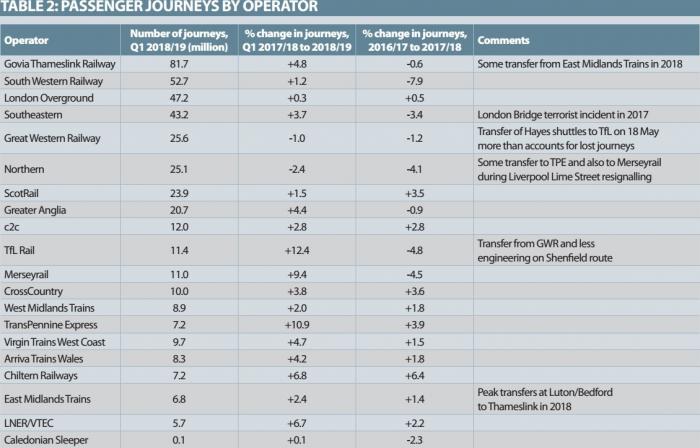
GIVEN THE trials and tribulations of the new timetable introduction on Northern and Thameslink and the collapse in performance thereafter, it was perhaps a surprise that passenger journeys from April to June were up 3.1% nationally compared with the same period in 2017/18, according to Office of Rail and Road statistics.
Table 1 shows the percentage change results by traffic category in the whole of the year 2017/18 and for Q1 (April to June) of 2018/19 for journeys, passenger kilometres and receipts, compared with the same period previous year.
The new timetable did not start until 20 May, more than halfway through the quarter. There were some positive situations in 2018 compared with 2017, in that there were fewer terrorism problems this year in both London and Manchester and while Thameslink had problems, Southern was operating both more extensively and effectively this year. Arguably engineering works were less intrusive in the London area in 2018; the very busy Easter programme was wholly in Q1 in 2017 whereas it was spread over the year end in 2018


There was also no General Election or purdah period this year, which I always used to reckon had a negative effect on journeys. Perhaps most importantly, the price of fuel has risen by about 15% over the year-on-year period, probably explaining why yet again fuel tax is not to be increased. Employment was higher in 2018 nationally.
To actually drill down we need to look at information by operator, which is shown for journeys in Table 2, for the year 2017/18 and Q1 2018/19 in percentage change on previous year. Also shown are the number of journeys by operator for Q1. The table is ordered by journey number total by TOC for Q1 to indicate how the stats are driven by the Thameslink, South Western and South Eastern franchises. The Q1 figures are specifically for the quarter to indicate the scale of the change from 2017/18 overall.
Note the strong growth on East Coast: the ORR points out that passenger kilometres grew more (7.4%) than journeys, which points to growth over longer distances (against a general trend towards shorter journeys). I suspect that the journey growth on Thameslink/Southern is on short-distance Coastway services, where traffic was down 20% in 2016/17 compared with two years previous in a situation where services were particularly affected by strikes and alternative modes.
The lack of growth on London Overground is surprising against the general situation but may reflect a move to other operators post London Bridge completion. The ORR report doesn’t mention a major reallocation of income within London but that is another possibility, as is competition from Über.
The report makes much of the move from seasons to daily tickets and this, together with shorter journeys, has something to do with improved yield but doesn’t explain the improved long-distance yields – the average fare per km in the quarter is 15.32p, well ahead of 14.72p for 2017/18 and another change in trends.
All told an interesting result that is positive for the industry. I’m not sure I would bet on a continuation in Q2 with hot weather and the World Cup, but time will tell. Theo Steel

Talgo shortlists six factory sites
SPANISH MANUFACTURER Talgo has shortlisted six potential sites for a UK factory, with a final decision on a preferred site expected in November. The possible sites are:
■ Mostyn Dock in North Wales;
■ Longannet and Hunterston in Scotland; and
■ Chesterfield, Leeds and St Helens in England.
The shortlist follows an 18-month search and discussions with landowners, development agencies, local authorities, research establishments, schools, colleges and universities. The company says the locations share great connectivity and would receive a major boost from job creation, with the factory potentially employing up to 1,000 people.
Talgo says it aims to enter the UK train market through what it calls ‘true manufacturing’, and instead of ‘assembling kits of parts from overseas’ it would source components from within the UK. It would also look to build for emerging overseas markets, boosting UK exports.
Talgo is bidding to build the first fleet of trains for HS2, with other shortlisted companies Alstom, CAF, Siemens and a joint venture of Bombardier and Hitachi. Bids for that contract are due to be submitted early next year.
